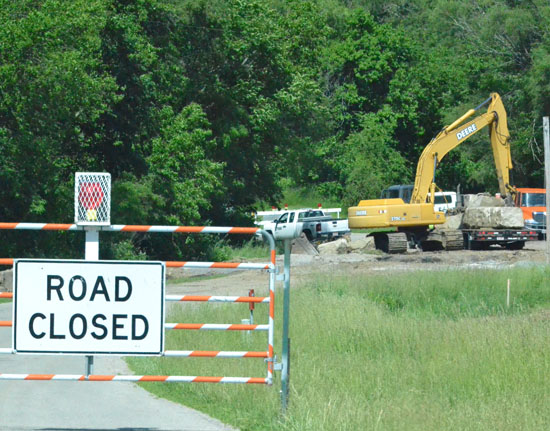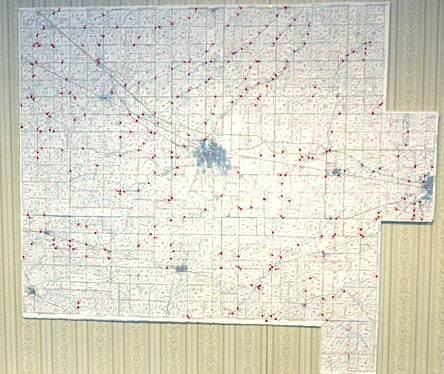Most county bridges said in good shape
DAVE MOSIER/independent editor

With high-profile bridge collapses like the one on Interstate 5 in Washington state back in May, Van Wert County residents should be relieved to know that the overall health of county bridges is pretty good — and steadily improving.
According to Van Wert County Engineer Kyle Wendel, the county has a total of 272 bridges, with 229 of those at least 20 feet long — the minimum length for inspection through the National Bridge Inspection System (NBIS). The county also has another 43 bridges between 10 and 20 feet long that are subject to local inspection.
The county’s NBIS bridge “sufficiency rating” is an average of 82.4 percent, just a tenth of a percent under the state average of 82.5 percent. That’s a big improvement in just the last 10 years, Wendel said, noting that the county had a sufficiency rating of 74 percent in 2002. “We’re in a lot better shape than we were,” he added.
Bridge sufficiency is a method of evaluating highway bridge data by calculating four separate factors to obtain a numeric value that is indicative of bridge sufficiency to remain in service. A rating of 100 percent would represent an entirely sufficient bridge, while zero percent would represent an entirely deficient bridge.
Sufficiency rating is essentially an overall rating of a bridge’s fitness for the duty that it performs, based on factors derived from over 20 NBI data fields, including fields that describe its structural evaluation, functional obsolescence, and how essential the bridge is to the public. A low sufficiency rating may be due to structural defects, narrow lanes, low vertical clearance, or any of many possible issues.
Of the 229 county bridges subject to NBIS inspection, 50 were rated in excellent condition, 77 are in very good condition, 61 bridges are in good condition, 15 in fair condition and only one in poor condition.
By law, each of the county’s bridges must be thoroughly inspected each year. For 12 years that was the job of longtime county employee Ron Keber, although Assistant County Engineer Kory Thatcher has now taken over those duties.
Thatcher said inspecting the county’s bridges takes approximately two months each year, with an average of a half-hour needed to inspect a bridge. “Steel truss bridges take much longer than that, but some of the smaller bridges take less time,” he noted.
Thatcher said each bridge must be given a visual inspection, as well as a “sounding” with a hammer and evaluation by several other criteria to ascertain if the structure is in good health.
Moreover, Wendel said, the evaluation criteria have gotten much more involved since the 2007 Minnesota bridge collapse on Interstate 35 over the Mississippi River that killed 13 people.
In addition to replacing bridges, the county engineer’s office load-rates bridges and posts weight limits on a number of bridges around the county. Wendel stressed, though, that posted bridges are not unsafe to the general motoring public. “It doesn’t mean that the bridges are ready to fail,” Wendel said, adding that most of the posted bridges were constructed with lighter materials than today’s bridges.
In addition, most of the posted bridges are on lightly-traveled roads with few houses on them.
It’s fortunate that most of the county’s bridges are in decent shape, since replacing deficient bridges is slow work, with an average of just four to five bridges replaced in a given year. “Every year we’re hacking away, replacing bridges that need it,” Wendel said, adding, “Luckily, bridges have a long life cycle, if they’re built properly.”

Although replacing bridges isn’t cheap, Wendel did note that the county now makes its own beams for bridges up to 40 feet long, which has resulted in a significant savings to county taxpayers. He said it would have cost an average of $100,000 to replace a 40-foot bridge before the county started making its own beams. Approximately $60,000 of that would have been the cost of the beams. Today, bridges built with county-manufactured beams cost as “little” as $40,000 for the entire structure.
Another cost-saving measure has been the closing of bridges on isolated dirt roads with few, or no, houses on them. Wendel said the number of operating bridges in the county has decreased from 291 in 2002.
Saving money is critical for the engineer’s department, though, since gasoline tax revenues, a primary source of operating revenues for the department, have decreased, largely because of the way gas taxes are levied.
Wendel said the tax is not based on the cost of gasoline, which has increased significantly over the past few years, but is a per-gallon tax only. With the cost of gasoline increasing, motorists are buying more hybrid and fuel-efficient vehicles, resulting in a decrease in the number of gallons of gasoline sold in Ohio.
That, in turn, has decreased the amount of money the county receives. “We’re not complaining or anything,” Wendel said, but he did acknowledge that it would be helpful if the gas tax structure was re-evaluated.
With 267 miles of roads to maintain, bridges aren’t the only structures the county engineering department has to deal with, although Wendel said having safe bridges is crucial. “We take it (bridge safety) very seriously,” the county engineer said. “It’s about our top priority.”
POSTED: 09/23/13 at 8:02 am. FILED UNDER: News







